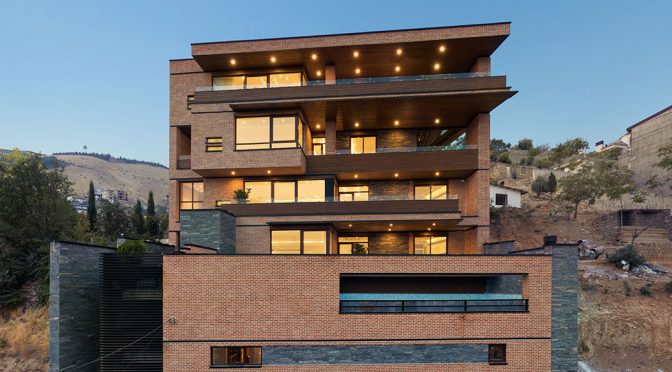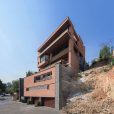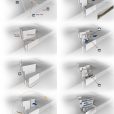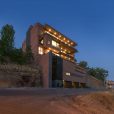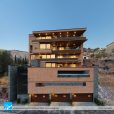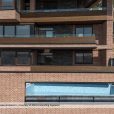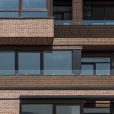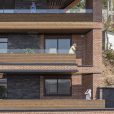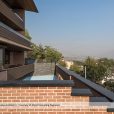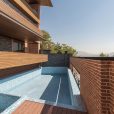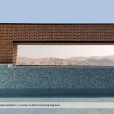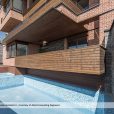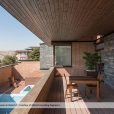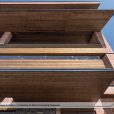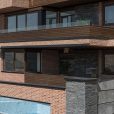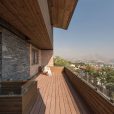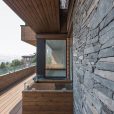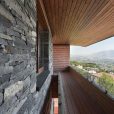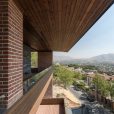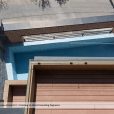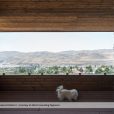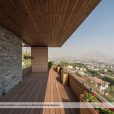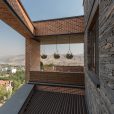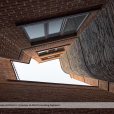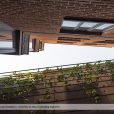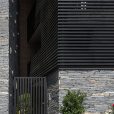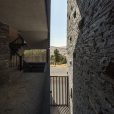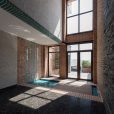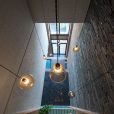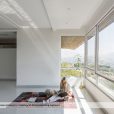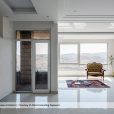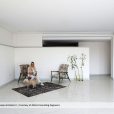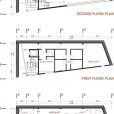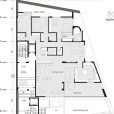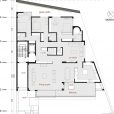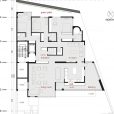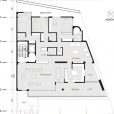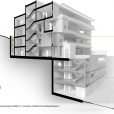خانه ـ آپارتمان لواسان
مهندسین مشاور آتیزیست (احسان مالکی)
راهیافته به مرحله نیمهنهایی نخستین دوره جایزه شایستگی معمار ایرانی (۱۳۹۷)
موقعیت: لواسان، تهران، ایران
تاریخ: ۱۳۹۵
مساحت: ۱۴۴۷ مترمربع
وضعیت: ساختهشده
کارفرما: علیرضا پورکاظم و شرکا
تیم طراحی: یکتا آفرین، شیما زهرایی، لیلی بهمن بیجاری، حسن عابدی
سازه: محمدرضا گودرزی
تاسیسات مکانیکی: علیرضا شادبخش
مدیر اجرایی: علیرضا پورکاظم
اجرا: عینالله گودرزی
نظارت: مهندسین مشاور آتیزیست
گرافیک: سعید فهیمپور، پژمان طیبی
عکس: استودیو دید
جوایز: تقدیرشده گروه مسکونی آپارتمانی جایزه معمار ۱۳۹۶
خانه ـ آپارتمان لواسان در زمینی به مساحت ۵۲۰ مترمربع، در شش طبقه، شامل چهار طبقه مسکونی (با متراژهای ۲۶۰ الی ۲۷۰ مترمربع) و دو طبقه مشاعات (لابی، پارکینگها، استخر)، طراحی و احداث شده است. این آپارتمان خانوادگی متعلق به چهار خواهر است که هر طبقه متعلق به یک خواهر (به همراه خانواده خود) است. باجناقها همگی دستی بر فرهنگ و اندیشه دارند، از تحصیلات در رشته فلسفه تا فعالیت در حراج آثار هنری در ایران و منطقه. بنابراین دیالوگی منطقی و مبتنی بر پایبندی به اصول فرهنگی معماری ایرانی و تبدیل به یک کاشانه خانوادگی (تفسیری امروزی از معماری ایرانی)، خواسته کارفرماها بوده است، ضمن اینکه قرارگرفتن این آپارتمان در مجاورت آرامستان کوچک توک مزرعه و اهمیت جایگاه عباس کیارستمی (که در اینجا آرمیده است) برای کارفرما، پروژه را در شرایط خاصی قرار میداد. همچنین سایت پروژه دارای یک دیوار ترانشه به ارتفاع ده متر از قسمت انتهایی زمین بود که برای نورگیری طبیعی، ایجاد یک حیاط خلوت در آن قسمت را ناگزیر میکرد. بنابراین پروژه از چند جهت، درگیر نیروها و پتانسیلهایی بود که میبایست در حین طراحی مورد توجه قرار میگرفت.
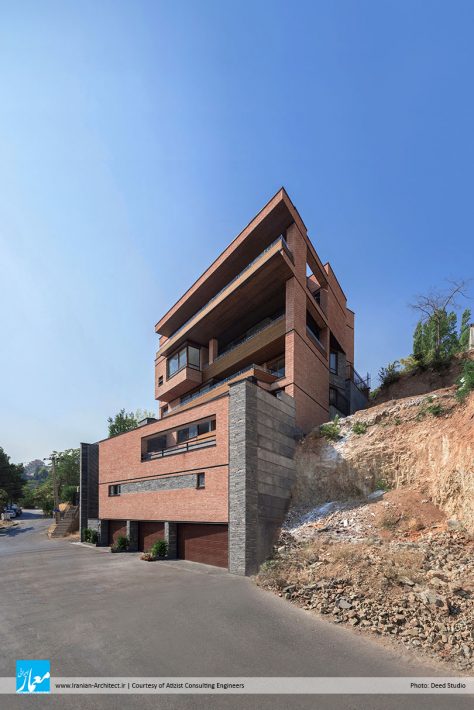
در خانه ـ آپارتمان لواسان، جایگذاری بنا در محیط، از اهمیت ویژهای برخوردار است. با اینکه بنا در منطقهای مرتفع، با دید به منظره لواسان، کوههای اطراف و همچنین دریاچه برخوردار است، اما به دلیل قرارگیری قبرستان توک مزرعه در ضلع غربی زمین، نمیتوان در این ضلع، از بازشو استفاده کرد. طراح با در نظرگرفتن این مقوله، چرخشی در حجم بنا ایجاد کرده که علاوه بر بعد زیباییشناختی، با پشتکردن به فضای قبرستان، بازشوها را برای استفادهکنندگان کاربردی کرده و در نتیجه، برای کاربر، چشماندازی زیبا، بدون دید به قبرستان خلق شده است.
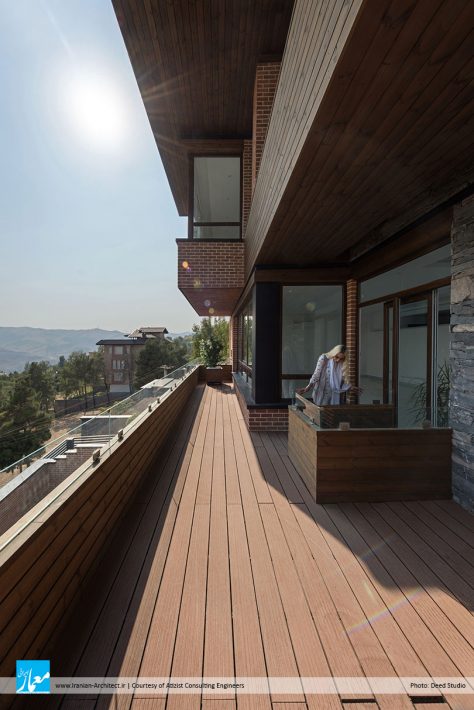
یکی از چالشهای پروژه، قرارگیری در شیب حدود ۴۵ درصد بود که با در نظرگرفتن طراحی سازهای و ترکیب آن با معماری، تفکیک فضایی در بنا ایجاد شده است. ورودی بنا در قسمت پایین شیب است که پارکینگها و فضای انباریها را شامل میشود و کاربر با طیکردن پلکان ورودی و آسانسور، به فضای لابی پروژه میرسد که یکی از شاخصههای بنا و نشانهای از نماست که به داخل کشیده شده است.
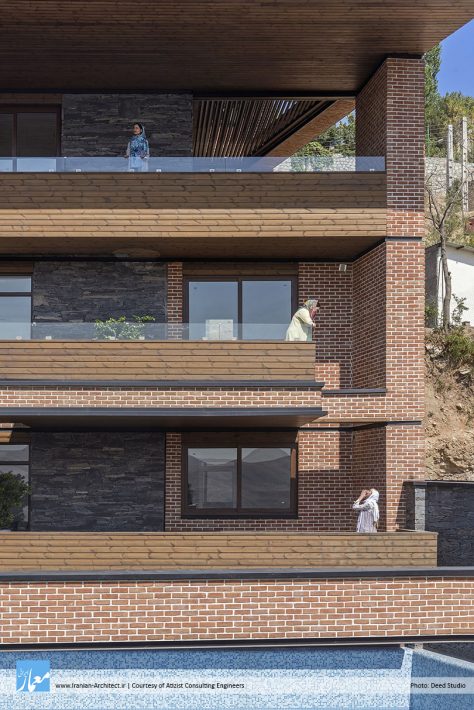
طراح در ایجاد اتمسفر فضاهای معماری ایرانی، به محوریت فضاهای باز محصور در معماری ایرانی توجه داشته است. حیاط در معماری بومی، محل برهمکنش ارتباطات و رویدادهای مشترک اهالی یک خانه بود و در این پروژه نیز، ایجاد تراسهایی با عمقهای متفاوت که دارای voidهای مختلف نسبت به هم هستند، این چهار واحد خانوادگی را به هم مرتبط کرده (پیوستگی در عین مستقلبودن) و منجر به حادثشدن روایتهایی از یک زندگی سنتی در یک ساختمان مدرن شده است. علاوه بر این تراسهای خانوادگی، پروژه دارای تراسهای خصوصی هم است.
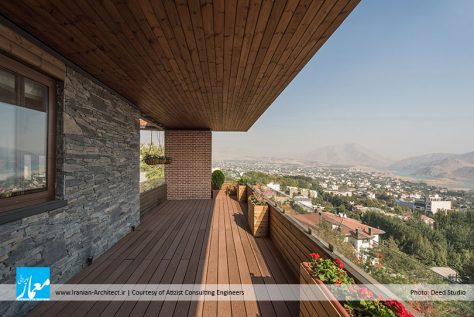
اتمسفر زمینه و بستر پروژه با حضور قدرتمند اجزاء مادی (مصالح) تولید میشود و تشدید تجربه مادهگرایی، منجر به تقویت احساس واقعیت و جسمانیت در فضا میشود. همچنین تصاویر برخاسته از ماده، تجربههای عمیقتر و ژرفتری را نسبت به تصاویر برخاسته از فرمگرایی صرف بر جای میگذارند. طراح با توجه به محل قرارگیری پروژه، در انتخاب متریال، ایدههای خود را به کارفرما ارائه کرده که در نتیجه، از متریالهای اقلیمی، شامل سنگ لاشه، آجر و چوب، استفاده شده و به این ترتیب، بنای ساختهشده به محیط اطراف خود کاملا احترام گذاشته است. مصالح، تخیل و احساسات حاصل از ادراک ناخودآگاه را برمیانگیزانند و در این پروژه، مصالح حضوری قوی و در تعامل با ساکنین دارند.
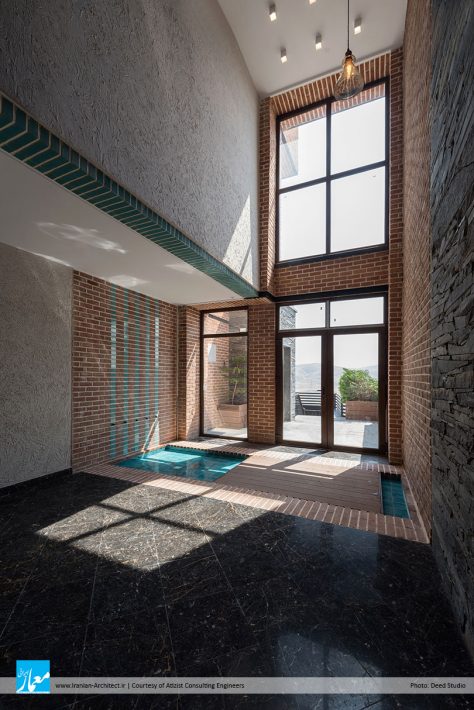
ایده حیاط ایرانی از طریق فراخوانی حوض و فواره و کاشی فیروزهای، در لابی اصلی ساختمان متجلی شده است. لابی دارای عناصر فضایی مختلفی است که به غیراز آبنما و اجزای آن، دارای ارتفاعات مختلفی بین سه تا ده متر است که از طریق سقف نورپردازی شده است؛ گویی وارد حیاط خانهای سنتی شدهایم که هریک از اعضای خانواده، از موقعیتهای مکانی خاص خود، نظارهگر حضور دیگران هستند و دستگاه پله نیز آزادانه، امکان دید به چشمانداز منطقه لواسان را برای گذرگنندگان از آن فراهم میکند. فضای لابی، با اضافهشدن آبنما و کاشیهای فیروزهای و همچنین گذر از روی پل چوبی که بر روی آبنما قرار گرفته است، حس حیاطها و ورودیهای خانههای ایرانی را برای بازدیدکننده القاء میکند.
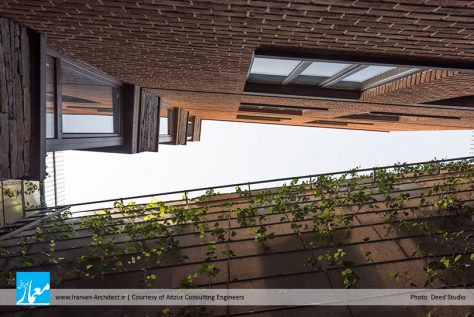
دیوار حیاطخلوت این ساختمان، نزدیکترین دیوار به آرامگاه عباس کیارستمی است. با تامل در عکسهای کیارستمی، روایت دیگری از دیوار را در آثار او میبینیم: روایت نقش طبیعت بر آن، آمیزهای از زمان، نور و رنگ بر چهره دیوار. از نگاه او، دیوار پردهای است که طبیعت بر آن، نماهای گذرا را نقاشی میکند. برای ما معماران، دیوار تکستی بوده است که آنها را بر طبیعت، به مثابه کانتکست نگاشتهایم. لذا در این پروژه، دیوار حیاطخلوت به جدارهای سبز تبدیل شده است.
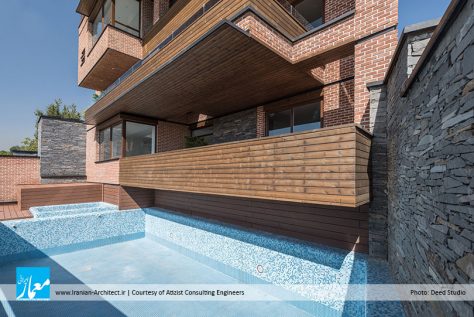
طراح سعی کرده است با چرخش بنا و همچنین تراسهای جلوآمده وسیع، در عین شاخصبودن در کنار دیگر ساختمانهای اطراف، مانع اشراف همسایگان بر فضاهای خصوصی، از جمله حیاط و استخر که در محوطه قرار گرفته است، شود. استخر به گونهای طراحی و جایگذاری شده است که کاربر را با یک تجربه جدید از فضای استخر مواجه میکند؛ استفادهکنندگان هنگام استفاده از استخر، شاهد منظره وسیعی از دریاچه هستند، گویی استخر انتهایی ندارد و امتداد آن به دریاچه متصل شده است.
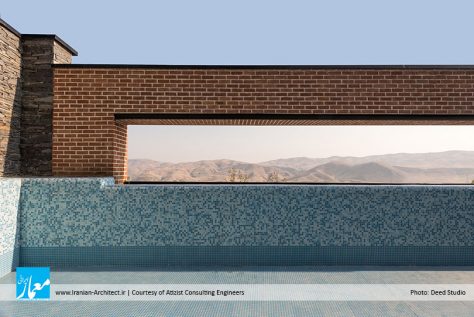
در طراحی داخلی بنا، ضمن در نظرگرفتن حس زیباییشناسی و کاربرد هریک از فضاها، با بهکارگیری خلاقانه نور طبیعی، محیط سرشار از روشنایی شده و طراح، ضمن دعوت هر چه بیشتر طبیعت به فضای داخلی، خانه را برای کاربران، محیطی مملو از نور و آرامش کرده است.
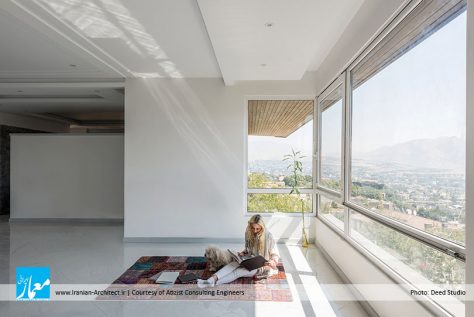
پروژه خانه ـ آپارتمان لواسان دارای گفتمانهای مؤثری از فضا و مکان است و صرفا به دلیل موقعیت قرارگیری در ارتفاع مناسب، چشمانداز لواسان را هدف قرار نداده است. این ساختمان، ویژگی حسی مخاطب را در خود درگیر میکند و درک محیطی فضاهای آن، تصاویر حاصل در شبکیه را به یک استلزام بدنمند در فضایی که در آن حضور داریم، مبدل میکند و حس اتمسفری ما را ارتقا میدهد. معماری صرفا بصری، خاصیت جداکنندگی و کنترل دارد، در حالی که معماری مبتنی بر لامسه، اتصالدهنده و یکپارچهکننده است و حساسیت لامسهای از طریق مادیت، مجاورت، شناخت و صمیمیت حاصل میشود، عواملی که هویت در خانه بودن را ارتقاء میبخشند.
Lavasan House-Apartment
Atizist Consulting Engineers (Ehsan Maleki)
Semi-Finalist of Iranian Architect Merit Award 2018
Location: Lavasan, Tehran, Iran
Date: 2016
Area: 1,447 sqm
Status: Completed
Client: Alireza Pourkazem & Partners
Design Team: Yekta Afarin, Leila Bahman Bijari, Shima Zahraei, Hasan Abedi
Structural Consultant: Mohammadreza Goudarzi
Mechanical Consultant: Alireza Shadbakhsh
Construction Manager: Alireza Pourkazem
Construction: Einollah Goudarzi
Supervision: Atizist Consulting Engineers
Graphic: Saeed Fahimpour, Pejman Tayebi
Photo: Deed Studio
Awards: Honorable Mention of Memar Award 1396 in Residential Apartments Category
Lavasan House-Apartment has been built in a terrain with 520 sqm area, in six floors consisting of four residential floors and two public-use floors. The residential units have areas in a range of 260-270 sqm and the public-use areas include a lobby, parking, and pool. The project is a domestic apartment owned by four sisters who each possess one of the residential floors. Their husbands are all men of culture and thought, from studying philosophy to participating in art auctions. So, a logical dialogue based on the cultural principle of Iranian architecture and through this ultimately reaching to a domestic home (a modern interpretation of Iranian architecture) was the main client`s request. At the same time, we had a specific situation cause of the position of the project which was adjacent to the small cemetery of Tok Mazra’e (the cemetery which is the location of many well-known important persons including Abbas Kiarostami). The site had a trench wall with the height of 10 meters starting from the end of ground which forced us to have a backyard, in order to provide more natural lights. So, the project was affected by different forces and potentials coming from different directions.
In this project, the positioning of building within its environment is of major importance. Although the building is locating in a high region which has a great view to Lavasan, round about mountains and also a beautiful lake, the location of the cemetery of Tok Mazra’e in the west of the main terrain, forced us to not have any kind of openings in this aspect. According to this, we suggested a rotation in the general volume to not only have more aesthetic possibilities, but also provide wide openings for the users through turning back from the cemetery. In addition, we could have a spectacular view, with no facing to the cemetery.
One of the challenges we confronted, was a steep slope of 45%. Nevertheless, we could have created a good spatial separation, considering the structural design and its mixture with architecture. The main entrance was at the lowest point of the slope where includes parking area and storage. The user could reach the lobby by passing through the entrance stairs and an elevator, which is the main feature of the building and a sign of elevation penetrating into the building.
For creating an atmosphere of Iranian architecture, the designer has had a major concern about the enclosed open spaces. In indigenous architecture, the yard was the interaction point of dwellers’ communications and their shared events. In this project, we aimed to connect these four domestic units through the use of terraces of different depths which open a variety of voided into each other (a synchronization of continuity and independency).
The Atmosphere of context was responded by the means of materials. The intensification of materialism experience enforced the sense of being real and tangible. Here, we should insist that the images provoked of materials would have more profound experiences than that of mere formalism. The designer, in regard to the location of the project, proposed his idea in term of material selecting; the idea largely relied on climatic material consisting of rubble stone, brick, and wood, through which the building shows his great respect to its surrounded environment. Materials could evoke more imaginations and sensations that are results of unconscious perceptions. Hence, materials have a significant presence and interaction with the dwellers.
The idea of Iranian yard was manifested through the recall of pools, fountains and turquoise tiles in the main lobby. The lobby has different spatial elements that with an exception of fountain, have different heights of a range of 3-10 meters. The lighting was provided from the ceiling which seems you are entering the yard of a traditional house in where each of family members is looking other’s presence from their own position. Besides, the staircase let people who using it, have a vast view of Lavasan. In the lobby, with the use of fountain and turquoise tiles and also a wooden bridge over the fountain, we provide users the sense of Iranian houses’ yards and entrances.
Wall of the backyard is the closest wall to Abbas Kiarostami’s tomb. With pondering in Kiarostami’s photos, we could see another narration of the wall in his artworks; the narration of nature’s inscription on it, a mixture of time, light, and color on the wall’s face. In his point of view, a wall is a curtain on which nature paints transient elevations. For us, the wall was a text that we could have inscribed it on nature as the context. So, in this project, the wall was transformed into a green surface.
The designer through the rotation of the building and also the protrusile terraces, aimed to create a significant building that there is no direct view from its neighbors to its private spaces such as yard and pool. The pool has been designed in a way that its users could have a vast view of the lake, at the time of using it. It seems that there is no end for the pool and its continuity has been connected to the lake, a marvelous experience of the pool for the users.
In the interior design, in regard to aesthetic sense and the function of each space, through the creative use of natural light, we could have an environment deeming with light. Moreover, the designer in addition to inviting nature in, has made the home an environment full of light and peace.
The project has effective discourses about the notions of space and place and did not merely aim the view of Lavasan through its positioning at a suitable height. The building involved the sensational feature of the user in itself. The environmental perception of its spaces transforming the captured retinal images to an embodied implication within a space in which we are not present and would develop our atmospheric sense. An all visual architecture has a controller and separator character, but an architecture based on tactile sensation, is connecting and cohesive, and the tactile sensation could be provided through materiality, juxtaposition, recognition and intimacy, the factors which reinforce the identity of being in a home.

